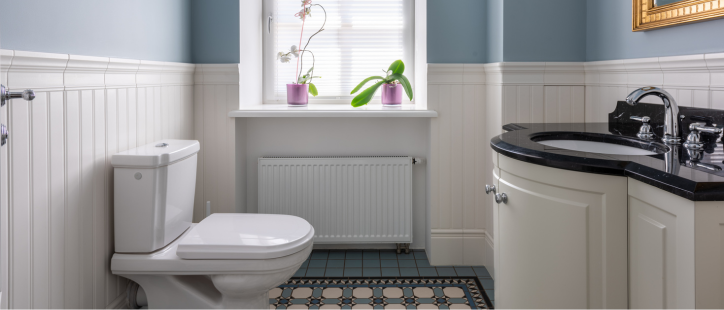A slow-flushing toilet can be a frustrating and inconvenient problem to deal with. When you flush your toilet, you expect a swift and efficient removal of waste and water. However, if you notice that your toilet is flushing slowly, it’s essential to address the issue promptly to prevent further inconvenience and potential plumbing problems. In this helpful article, we’ll explore the common causes of a slow-flushing toilet and provide practical solutions to get your toilet back to its optimal performance.
Common Causes of a Slow-Flushing Toilet
- Partial Clog in the Trap or Drain: One of the most frequent causes of a slow-flushing toilet is a partial clog in the toilet’s trap or drain. This obstruction can impede the flow of water and waste, resulting in a slow flush.
- Mineral Buildup in the Rim Jets: Over time, mineral deposits, especially in areas with hard water, can accumulate in the rim jets of your toilet. These deposits can restrict the flow of water, reducing the toilet’s flushing power.
- Low Water Level in the Tank: If the water level in your toilet tank is too low, it may not provide enough force to create a strong flush. This can happen due to a malfunctioning fill valve or float.
- Flapper Problems: A deteriorating or improperly adjusted flapper can affect the toilet’s flushing efficiency. If the flapper doesn’t lift completely or doesn’t seal properly, it can cause a slow flush.
- Blocked Vent Pipe: The vent pipe is a crucial component of your plumbing system that helps maintain proper air pressure in the drain pipes. If the vent pipe is blocked or obstructed, it can lead to slow drainage and flushing issues.
- Sewer Line Blockage: In more severe cases, a slow-flushing toilet could be a symptom of a blockage in the sewer line that connects your home to the municipal sewer system. This can lead to slow drainage throughout your plumbing system.
Solutions to Fix a Slow-Flushing Toilet
Now that we’ve identified some common causes, let’s explore the solutions to address a slow-flushing toilet:
1. Clear Partial Clogs:
- Use a Plunger: The simplest and often most effective solution for a clogged toilet is using a plunger. Ensure there’s enough water in the bowl to cover the plunger’s cup. Create a tight seal and push and pull forcefully to dislodge the clog.
- Auger or Snake: If the plunger doesn’t work, consider using a toilet auger or snake. Insert the auger into the drain and turn the handle to break up or retrieve the clog.
2. Remove Mineral Buildup:
- Vinegar Soak: To remove mineral deposits from the rim jets, pour white vinegar into the overflow tube in the toilet tank. Let it sit for several hours or overnight, and then scrub away any remaining deposits with a toilet brush.
3. Adjust Water Level:
- Check the Tank Water Level: Open the toilet tank and inspect the water level. It should be around half an inch below the overflow tube. If it’s too low, adjust the float or fill valve to raise the water level to the appropriate height.
4. Fix Flapper Issues:
- Inspect and Replace the Flapper: Check the condition of the flapper. If it’s worn or damaged, replace it with a new one. Ensure that the flapper seats properly and creates a tight seal when the toilet is not in use.
5. Unblock Vent Pipe:
- Clear Vent Obstructions: If you suspect a blocked vent pipe, it’s best to call a professional plumber. They can inspect and clear any obstructions in the vent system, ensuring proper air pressure in the drain pipes.
6. Address Sewer Line Blockages:
- Professional Inspection: If you’ve tried all the above solutions and the problem persists, it may be a blockage in the sewer line. Contact the licensed plumbers at Maffei Services to conduct a thorough inspection and, if necessary, clear the blockage.
Tips for Preventing Future Slow-Flushing Issues
Once you’ve resolved the slow-flushing toilet problem, consider implementing these preventive measures to maintain a smooth-flowing toilet:
- Regular Maintenance: Perform periodic checks of your toilet, including the tank, flapper, and rim jets, to catch and address any issues early.
- Use Less Toilet Paper: Excessive toilet paper use can contribute to clogs. Use only an appropriate amount, and consider using thinner toilet paper if clogs are a recurring problem.
- Avoid Flushing Non-Flushable Items: Remind household members not to flush non-flushable items like paper towels, sanitary products, or baby wipes, as they can easily lead to clogs.
- Install a Water Softener: If you live in an area with hard water, consider installing a water softener to reduce mineral buildup in your plumbing fixtures.
- Regularly Clean Rim Jets: To prevent mineral deposits from building up in the rim jets, conduct periodic vinegar soaks as mentioned earlier.
- Educate Household Members: Teach everyone in your household about proper toilet use and disposal habits to avoid clogs and other plumbing issues.
Maffei Services in Just One Call Away When You Have a Toilet Flushing Slowly
A slow-flushing toilet can be a nuisance, but it’s a common issue with practical solutions. By identifying the underlying cause and taking appropriate steps to address it, you can enjoy a smoothly functioning toilet once again. Remember that routine maintenance and preventive measures are key to keeping your toilet in optimal condition and preventing future slow-flushing problems. If you encounter persistent issues or suspect more significant plumbing problems, don’t hesitate to seek professional assistance from Maffei Services to ensure your plumbing system remains in excellent working order.



